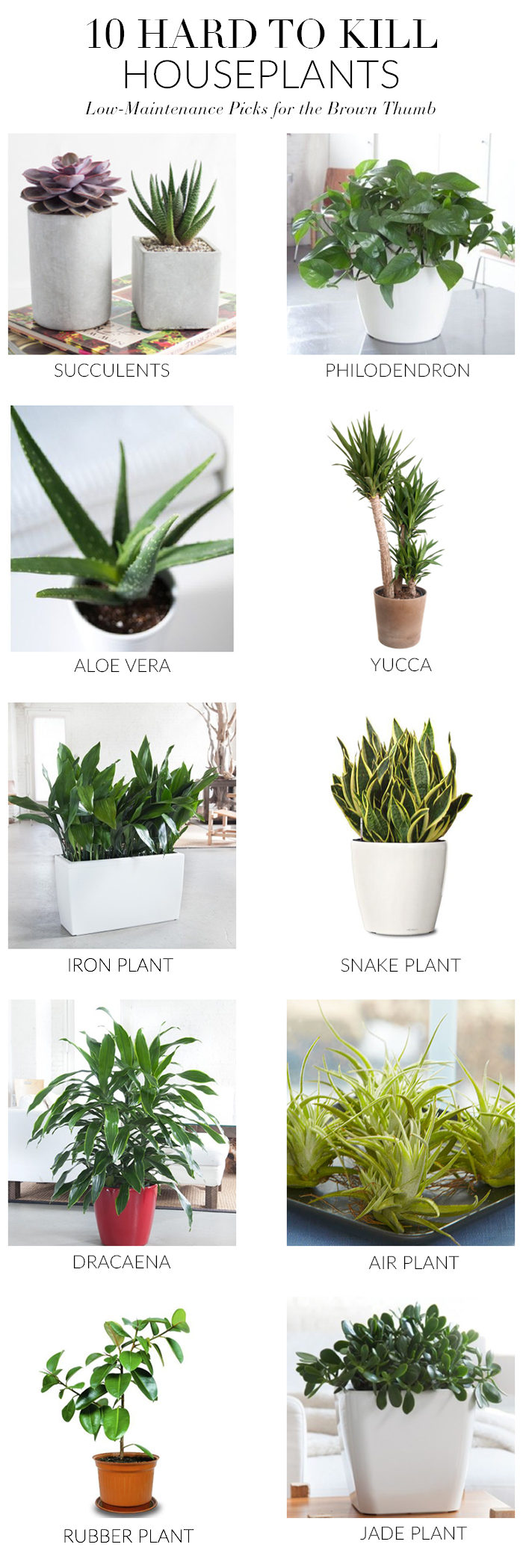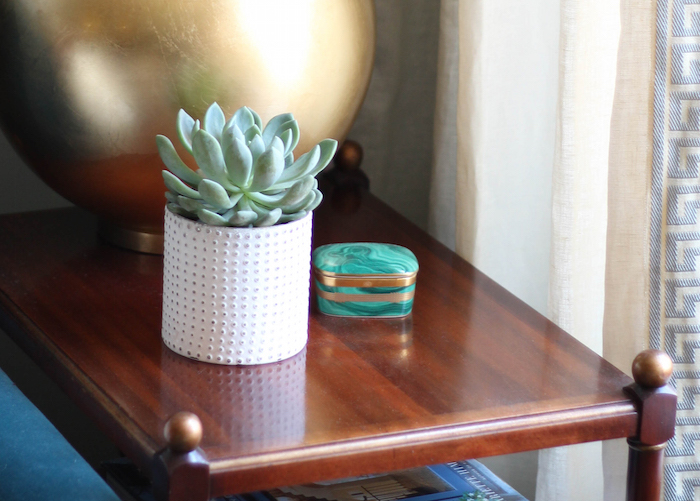As much as I pride myself on my domestic abilities I must admit that when it comes to maintaining houseplants, I am a notorious brown thumb! I love plants because they add wonderful color and life to your home, but I’ve never been particularly successful in keeping any plant alive for an extended period of time. I recently took home this succulent (pictured above) from a photoshoot and if you know anything about succulents you’ll know that they are notoriously hard to kill. I’m determined to keep this thing alive and if I can’t, I’ll consider myself a failure forever! (Ha!) In honor of my new succulent, I thought all of your brown thumbs like me might appreciate this roundup of my 10 favorite house plants that are low-maintenance and hard-to-kill. I also included basic care guidelines for each one below. Some of these plants may be toxic to animals so if you have a pet, be sure to do your research to ensure they are safe for your furry friend and also lookup more detailed care instructions if you have further questions on maintenance!

SUCCULENTS
Succulents like bright, indirect sunlight and need to be potted in well-draining soil. Water once per week and be sure not to overwater. Your soil should completely dry out in between waterings.
PHILODENDRON
Philodendrons prefer partial shade and a well-draining soil. When the top 2-3 inches of the soil dries out, it’s time to re-water. Keep the soil slightly moist in the winter. In the summer mist the leaves regularly. Bonus – philodendrons are a great, natural air purifier as they help filter toxins from the air!
ALOE VERA
Aloe vera plants prefer bright, direct sunlight. Water when the soil is dry 2-3 inches below the surface, about once every week and a half to two weeks or so. It will require less watering in the winter.
YUCCA
Yucca plants don’t need a lot of attention but prefer bright, indirect sunlight. Yucca plants are known for being drought tolerant so constant watering isn’t necessary. Once every 10 days or so should do the trick.
CAST IRON PLANT
They don’t call this a cast iron plant for nothing. This nearly indestructible plants can handle low light, extreme temperatures and can survive for a good length without water. However, It’s still a good idea to keep the soil moist for healthy growth by watering every 2-3 weeks.
SNAKE PLANT
Sansevieria, also known as snake plant or mother-in-law’s tongue can tolerate low light, a variety of temperatures and like the cast iron plant, doesn’t need constant watering. Water when the soil is dry, usually once a week. In the winter moths water once per month.
DRACAENA
Dracaena grows best in bright, indirect light and can also tolerate low-light conditions although it may not grow as quickly. This plant prefers warmer temperatures. Be sure to remove any yellowing leaves and trim brown tips to the natural leaf shape as needed. This is also a great plant for natural air purification.
AIR PLANT
Air plants are awesome because they grow without soil. They need indirect sunlight and to water them simply submerge in water for 10-12 hours once every two weeks or so. Mist leaves once per week or if you notice the leaves beginning to curl.
RUBBER PLANT
Rubber plants can thrive in a variety of light conditions and need evenly moist soil for optimal growth. Be careful not to overwater to avoid rotting. Rubber plants are also very susceptible to envrironmental changes so keep it put in one place vs moving it around your home. This plant is also a great air purifier!
JADE PLANT
Jade plants need full sun in order to grow properly and need to be drained well. Allow the soil to dry out completely before each watering. Softening leaves indicate it’s time for more water.







5 Comments
These are the perfect plants for me, haha. I love the look of the aloe vera plant. Plus, it has so many benefits!
The Office Stylist
http://www.theofficestylist.com
I plant ALOE VERA and SNAKE PLANT in my home and they are great that making my house greener. I don’t have much time to take care of them but they are still very green and strong.
MyInflatablePoly.com
http://myinflatablepoly.com/
Cool your plants I do not have a green thumb in Italy it says so
Please check my last post blog http://www.welovefur.com
http://www.welovefur.com/looks/bye-bye-holiday/
I like these plants because the don’t need much care just water once per week.
ALOE VERA and Cacti are the ONLY plants that survive in my tiny space. As much as i love succulents, I just don’t have enough natural light in the areas I love to display them which leads to soil that doesn’t dry well and poor dead plants.
Thanks for the round-up, I will definitely try a small Snake Plant
xx,
Jess